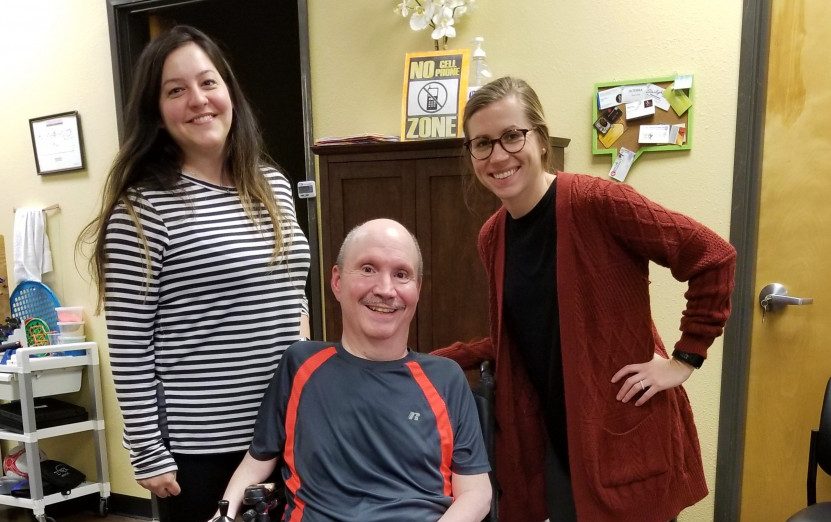Follow SMA News Today’s Physical Therapy Coverage

By Michael Morale, Bionews Services’ Director of Multichannel Content
Most people go to physical therapy because they’ve suffered an injury or are recovering from surgery. Previously, those of us with spinal muscular atrophy (SMA) were told not to do physical therapy because stressing our muscles to make them stronger could do more harm to our bodies than good.
That changed in late 2016 when the U.S. Food and Drug Administration approved Biogen’s Spinraza (nusinersen), a treatment that allows our bodies to produce the protein needed to build and sustain muscle. Quite a few patients with SMA who are getting Spinraza treatments have told me they have received permission from their neurologist or doctor to begin physical therapy. This marks a new chapter in our lives.
My first physical therapist, Laura, worked with me to improve my arms’ muscle strength. We gave much of our attention to the biceps and triceps. While we had limited success in building these particular muscles, my right arm did become a little stronger, giving me a bit more independence in my day-to-day activities.
We then began working on core-strengthening exercises to improve my abdominal muscles, as well as those in my back, shoulders, and neck. Over eight months, we saw dramatic improvements in my core strength, which helped me more easily keep my balance while sitting in my wheelchair. I could also do more for myself while going up and down the ramp in my handicap van and maneuvering my electric wheelchair on uneven surfaces. I no longer needed anyone to put their hand on my chest to keep me from falling forward. These types of small muscle improvements are monumental because my confidence expanded exponentially alongside my increased independence.
In 2018 I told Laura that I was experiencing quite a bit of numbness and soreness in my right leg. She advised me to see my primary care physician, who immediately sent me to a vascular and thoracic surgeon. After ruling out a blood clot, the surgeon ordered a CT scan on my pelvic region, which included my lower abdominal and right hip and leg muscles. As a result, I was diagnosed with severe muscle and nerve damage in my right hip and leg.
The test results showed that the muscle and fat in my right hip and buttocks have virtually disappeared, leaving me to sit on bone and nerves. Once my physician received the diagnosis, she wrote a prescription so that Laura and her team of therapists could start working on range-of-motion and flexing exercises for my hips, legs, knees, ankles, and feet. I’d been doing these exercises for a couple of weeks when Laura went on maternity leave, and her physical therapy assistant, Emily, took over for her. Emily has been working with me for almost a year now. Most patients do physical therapy for six to eight weeks. SMA patients require a different approach because our physical therapy will probably continue for the rest of our lives.
Over on SMA News Today HCP, my therapists and I have been working on a whole series of articles about my physical therapy approach. While these articles are geared primarily toward healthcare professionals, you might find them interesting and informative, as well. Laura and Emily have written some great articles about physical therapy for SMA patients. They cover quite a few of the exercises they do with me — exercises for sitting unassisted and balancing, range-of-motion and flexing exercises for my hips and legs — how to help a patient with SMA recover from pneumonia more quickly, and many other interesting topics.
These articles have some great information that you can share with your doctors and physical therapists, and possibly utilize in your workout routines. I’m not saying that everyone will benefit from the exercises I’m doing, but if your doctor and physical therapists approve of them, you may see some of the benefits I have. My hopes and prayers are that you do.
Be sure to check out Laura and Emily’s articles on the SMA News Today HCP site. We try to average one article per month with a focus on improving quality of life for patients with SMA.
***
Note: SMA News Today is strictly a news and information website about the disease. It does not provide medical advice, diagnosis, or treatment. This content is not intended to be a substitute for professional medical advice, diagnosis, or treatment. Always seek the advice of your physician or other qualified health provider with any questions you may have regarding a medical condition. Never disregard professional medical advice or delay in seeking it because of something you have read on this website. The opinions expressed in this column are not those of SMA News Today, or its parent company, Bionews Services, and are intended to spark discussion about issues pertaining to spinal muscular atrophy.







